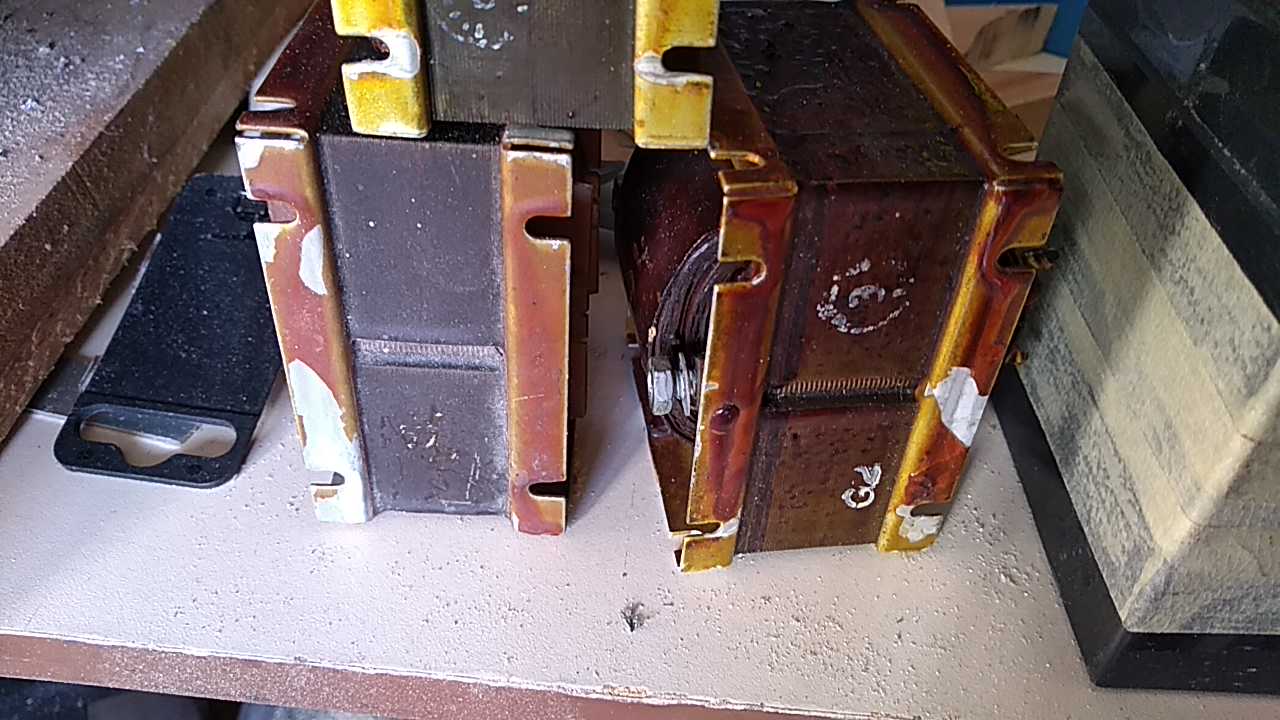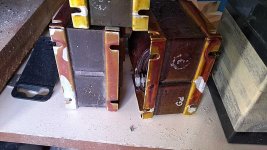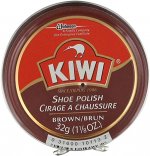Hi, I have a few old transformers like these probably Partridge ones where the varnish has chipped. It would be nice to patch them up, for aesthetic reasons, but what old varnish is it, and even available in the 21st century.
Thanks.

Thanks.
Attachments
Last edited:
We have a bottle of it somewhere, but the guy who will know what it is exactly is not here. I'll try to ask for you next week
JMO, no rust = no bother. If you have rust, gently brush it away with a soft bristle toothbrush. Follow with a rust converter. The laminations are insulated from each other by either varnish or some sort of adherent oxide. Electrical contact between laminations is bad, as eddy current losses will increase.
Thanks, I think the transformers work OK. For the amp I am building, they will be visible and it would be nice to smarten them up a bit, I like that old school dipped varnish look. I have found insulating varnish, but I am particularly interested in the rich dark colour of these above. I wonder if it is aging, or always like that?
This old varnish no longer is being made, its probably 70 years old.
Put them under a cover, transformer covers are being real cheap on those Alibaba sites.
Put them under a cover, transformer covers are being real cheap on those Alibaba sites.
You could take it up to an automotive paint store like PPG or even Napa auto parts store as they have automotive paint mixing machines there. They could possibly color match that for you and you could just touch it up , to keep the same color scheme that you were looking for. Just an idea and trying to think outside the box. But it does look like you won’t be able to match that color with a new type of insulating varnish or enamel or whatever they call it . because as they age they start getting that darker bronze copper looking color. Which , like you I like that color as well
As it needed to withstand elevated temps, do not use modern varnish, shellac etc. The real value if it was to prevent vibrations inside.
Maybe some info here:
Electrical Motor Manufacturing and Repair | Star Technology
Maybe some info here:
Electrical Motor Manufacturing and Repair | Star Technology
Found an interesting thread on Antique Radio forum:
Antique Radio Forums • View topic - Can I use ordinary shellac in transformer repair?
particularly this post by vitanola, (part of)
"glyptal (the "red dog", is a synthetic (phenolic resin) varnish, which ahs been available in both air-dry and baking formulations for about seventy years.
back in the 1920's, manufacturers often used "spirit varnishes", consisting of lac or copal resin dissolved in alcohol, or Trinidad asphalt dissolved in mineral spirits.
Vaccum impregnation with a hot asphalt/rosin mixture, as i do, is another good alternative. this practice was originated by Dudlo, I think, and their coils are legendary for their durability, even eighty years on."
Antique Radio Forums • View topic - Can I use ordinary shellac in transformer repair?
particularly this post by vitanola, (part of)
"glyptal (the "red dog", is a synthetic (phenolic resin) varnish, which ahs been available in both air-dry and baking formulations for about seventy years.
back in the 1920's, manufacturers often used "spirit varnishes", consisting of lac or copal resin dissolved in alcohol, or Trinidad asphalt dissolved in mineral spirits.
Vaccum impregnation with a hot asphalt/rosin mixture, as i do, is another good alternative. this practice was originated by Dudlo, I think, and their coils are legendary for their durability, even eighty years on."
Hi, I have a few old transformers like these probably Partridge ones where the varnish has chipped. It would be nice to patch them up, for aesthetic reasons, but what old varnish is it, and even available in the 21st century.
Thanks.
It's shellac. Itäs solvabel with spirits, a brush moistered in alcohol will patchup
the transformers.
It's shellac. Itäs solvabel with spirits, a brush moistered in alcohol will patchup
the transformers.
That would be very exciting, I have some Shellac, but it seems to be thinner, and more shiney. I was wondering if I could mix it with talcum powder to make it a bit thicker, but the Mrs says it is carcinogenic....
I will try some tomorrow and see what happens.
If it’s phenolic resin, it can still be obtained under the trade name Waterlox. It’s still used as a wood finish and it’s the only one of its type (phenolic) that I’m aware of. I refinished a coffee table with it a few years ago. Deep amber hue to it.
Last edited:
That's right. The trade name was Bakelite. Chemically it is phenol-formaldehyde co-polymer. Uncured resin is liqud. Transformers and other stuff were soaked in it, and then cured at high temperature to solidify the resin. This highly toxic industrial process was superseeded by epoxy impregnation.
Shoe polish. (Can you still buy brown polish?)
The old shellac is dark first because it was not highly purified for industrial use, second because they didn't clean the pot, third because it darkens over the decades. If you have not been chiseling on it, just use thin brown polish and work up to the tint.
*Rusty* iron can also be darkened and sealed with oil-base wood stain, but it won't stick on shiny metal or shellac.
The old shellac is dark first because it was not highly purified for industrial use, second because they didn't clean the pot, third because it darkens over the decades. If you have not been chiseling on it, just use thin brown polish and work up to the tint.
*Rusty* iron can also be darkened and sealed with oil-base wood stain, but it won't stick on shiny metal or shellac.
Attachments
Last edited:
Shoe polish. (Can you still buy brown polish?)
The old shellac is dark first because it was not highly purified for industrial use, second because they didn't clean the pot, third because it darkens over the decades. If you have not been chiseling on it, just use thin brown polish and work up to the tint.
Thanks, being daft it took me a while to get what you mean. The problem I have is that over the decades the metal has become a bit bent and some of the varnish has fallen off. I have a cunning plan however. I am going to attempt to make some varnish, fools rush in, I found some phenolic resin on ebay, and I have various oils and solvents. I suspect the making process would be dangerous and liable to catch fire, and be toxic, but hey, it didn't kill off all our ancestors. If that doesn't work I'll give the shellac shoe polish a go. 🙂
I think it is shellac. Test with concentrated alcohol on a brush.
If it is shellac it will slowly solve the varnish and you could spread
some of it on the naked surfaces.
If it is shellac it will slowly solve the varnish and you could spread
some of it on the naked surfaces.
I have some shellac, and iirc it dissolves any shellac it is put on to, it doesn't touch the varnish on that particular transformer. It is a promising colour match though. Be interesting to see what it looks like when it dries.
Not shellac AT ALL.
It is NOT re-soluble into anything.
Shellac belongs in furniture, musical instruments, etc, this is Industrial stuff.
Old style was either some kind of phenolic varnish, which was later oven cured, or oil based thick varnish, which first dried , then cured by slow oxidation.
The key word being **cured** , which is an irreversible hardening process.
Commercially making transformers for over 50 years now, and that impregnation varnish was already old when I started, do the Math.
Two kinds: oven cure, which is the best, and a few years after I started doing it in the late 60´s, the fancy new kid in the block was "air cure".
A mixed blessing: oven cure could be used down to the last drop, while with air cured sometimes you were left with half or third of a can gelified , useless for anything else.
It is NOT re-soluble into anything.
Shellac belongs in furniture, musical instruments, etc, this is Industrial stuff.
Old style was either some kind of phenolic varnish, which was later oven cured, or oil based thick varnish, which first dried , then cured by slow oxidation.
The key word being **cured** , which is an irreversible hardening process.
Commercially making transformers for over 50 years now, and that impregnation varnish was already old when I started, do the Math.
Two kinds: oven cure, which is the best, and a few years after I started doing it in the late 60´s, the fancy new kid in the block was "air cure".
A mixed blessing: oven cure could be used down to the last drop, while with air cured sometimes you were left with half or third of a can gelified , useless for anything else.
- Home
- Amplifiers
- Tubes / Valves
- Vintage transformer varnish, what is it?

